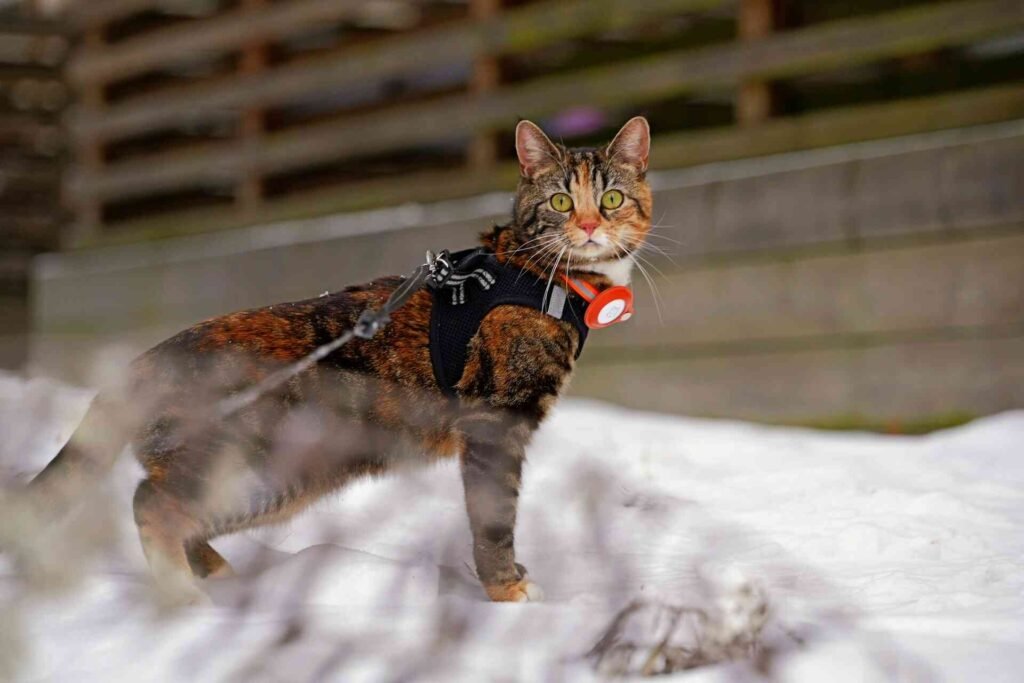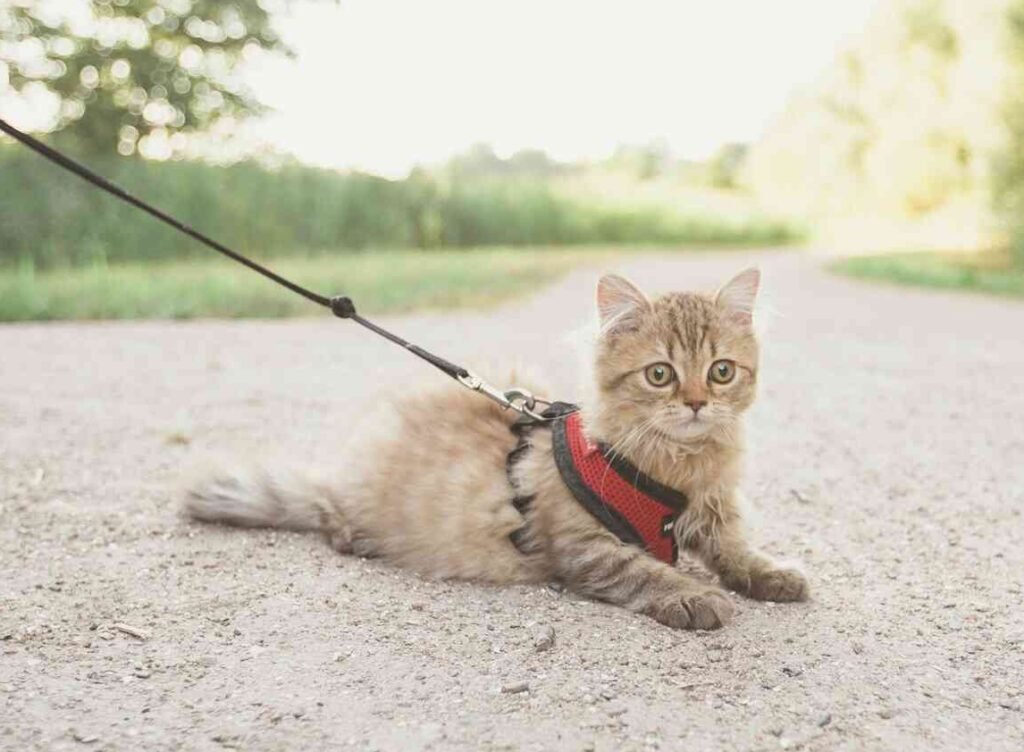In a world where dogs trotting alongside their owners is a common sight, the idea of walking a cat on a leash might seem unusual. Yet, this practice is gaining popularity among cat parents who want to safely expose their feline friends to the great outdoors. But can you walk a cat on a leash, or is this just a pipe dream for those envious of dog walks? The answer might surprise you.

The Truth About Walking Cats on Leashes
Yes, you absolutely can walk a cat on a leash, which doesn’t mean you always should! While not every cat will take to leash walking with the same enthusiasm as most dogs, many cats can be successfully trained to enjoy outdoor adventures while safely secured.
Walking your cat can offer numerous benefits:
- Mental stimulation and environmental enrichment
- Physical exercise to combat obesity
- A safe way to satisfy outdoor curiosity
- Quality bonding time between you and your feline
- A controlled alternative to free-roaming (which can be dangerous for cats and local wildlife)
The key is understanding that walking a cat is quite different from walking a dog, cats don’t typically “go for walks” in the traditional sense but rather engage in guided exploration at their own pace.
Which Cat Breeds Are Easiest to Walk on a Leash?
While any cat can potentially be leash-trained with patience, some cat breeds you can walk on a leash more easily than others due to their temperament and personality traits:
| Breed | Leash Training Potential | Notable Traits |
|---|---|---|
| Bengal | Excellent | High energy, curious, adventure-seeking |
| Abyssinian | Very Good | Athletic, inquisitive, confident |
| Savannah | Excellent | Dog-like, adventurous, highly trainable |
| Maine Coon | Good | Generally adaptable, intelligent, social |
| Ragdoll | Moderate | Relaxed, people-oriented, trainable |
| Siamese | Good | Vocal, intelligent, often enjoy interaction |
| Norwegian Forest Cat | Good | Outdoor heritage, sturdy build |

That said, a cat’s individual personality matters more than breed. We’ve seen mixed-breed shelter cats who adore their leash adventures, while some purebred cats from “leash-friendly” breeds want nothing to do with the outdoors.
Choosing the Right Harness and Leash
Before attempting to walk your cat, you’ll need the proper equipment. Never use a collar alone for walking a cat, they can easily slip out or choke themselves if startled.
Harness Types:
- H-style harness: Features straps that form an H shape around the cat’s body
- Vest harness: Provides more coverage and may feel more secure for some cats
- Jacket-style harness: Maximum coverage, harder to escape from
The best harness for your cat depends on their build and comfort level. Whichever style you choose, ensure it fits snugly (you should be able to fit two fingers between the harness and your cat’s body) but isn’t restrictive.
For the leash itself, opt for a lightweight, 4-6 foot lead. Retractable leashes aren’t recommended as they don’t provide adequate control and can startle cats with their retracting mechanism.
How to Train a Cat to Walk on a Leash: Step-by-Step Guide

Teaching a cat to walk on a leash requires patience and positive reinforcement. Follow these steps for the best chance of success:
Step 1: Harness Introduction
- Leave the harness near your cat’s favorite spots, allowing them to investigate at their leisure
- Rub the harness on their bedding to transfer familiar scents
- Associate the harness with positive experiences by placing treats on or near it
- Practice touching your cat with the harness while giving treats and praise
Step 2: First Fitting
- Choose a calm moment when your cat is relaxed
- Gently place the harness on your cat without fastening it
- Offer treats and praise during the entire process
- Keep these sessions brief, just a minute or two
- Gradually increase the time the unfastened harness stays on
Step 3: Wearing the Harness Indoors
- Once your cat accepts harness touch, fasten it loosely
- Immediately distract with treats, toys, or petting
- Let your cat wear the properly adjusted harness for 2-3 minutes at first
- Gradually extend wearing time over several days
- If your cat panics, remove the harness and try again later with a gentler approach
Similar to what we discuss in Why Cats Meow at Night, understanding your cat’s communication signals during this process is vital, if they seem distressed, take a step back.
Step 4: Adding the Leash
- After your cat is comfortable in the harness, attach the leash
- Let them drag the leash around (under supervision) to get used to the feeling
- Begin holding the leash loosely while following your cat around indoors
- Never pull or force direction, this isn’t a traditional “walk”
- Use treats to encourage movement if your cat freezes
Step 5: Outdoor Introduction
- Choose a quiet, contained area for first outings (a fenced yard is ideal)
- Carry your cat outside while wearing the harness and leash
- Set them down in a calm spot and let them set the pace
- Keep first sessions brief, 5 minutes is plenty
- Gradually increase outdoor time as confidence grows
Remember that patience is paramount. The process may take weeks or even months, but rushing can create negative associations that are difficult to overcome.
Common Challenges When Walking a Cat on a Lead
Even with careful training, you may encounter some challenges when walking a cat on a lead:
The Freeze Response
Many cats initially “freeze” or flop over when they feel the harness. This is normal, their instinct tells them something is restricting their movement. Continue with short, positive sessions and most cats will overcome this response.
Environmental Fears
Cats may be startled by noises, other animals, or unfamiliar objects. Start in quiet areas and gradually expose your cat to new stimuli as they build confidence. Always be prepared to pick up your cat and return home if they seem stressed.
As we explore in 9 Signs Your Cat Is Bored, providing environmental enrichment is important, but it needs to be done at a pace your cat can handle.
Escape Artists
Some cats are remarkably adept at wriggling out of harnesses. If your cat is an escape artist, try a more secure harness design or consider adding a safety measure like a light secondary connection.
Safety Considerations for Walking Your Cat
When taking a cat for a walk, safety should be your primary concern:
- Secure equipment check: Always inspect the harness and leash for damage before each outing
- ID tags and microchipping: Ensure your cat has proper identification in case of escape
- Parasite prevention: Keep flea, tick, and heartworm prevention current
- Environmental awareness: Avoid areas with off-leash dogs, heavy traffic, or toxic plants
- Weather monitoring: Protect from extreme temperatures and harsh weather
- Hydration: Bring water for longer outings, especially in warm weather
- Emergency plan: Have a carrier or transport bag available in case your cat becomes frightened
When Walking a Cat Might Not Be Appropriate
While taking cats on walks can be enriching, it’s not suitable for every cat or situation:
- Cats with certain medical conditions
- Extremely fearful or anxious cats
- Very old or frail cats
- Environments with uncontrolled dangers (e.g., high predator activity)
- During extreme weather conditions

If your cat consistently shows signs of stress during leash training, consider alternative enrichment activities. Our article on Strategic Cat Furniture Placement offers great indoor alternatives for environmental stimulation.
Alternative Outdoor Experiences for Cats
If traditional leash walking doesn’t appeal to your cat, consider these alternatives:
- Catios: Screened outdoor enclosures that allow safe outdoor access
- Cat strollers: Allow cats to enjoy the outdoors from the safety of a contained space
- Portable play pens: Set up temporarily in secure outdoor locations
- Window perches: Give indoor cats a view of outdoor activities
FAQ: Walking Cats on Leashes
Can Any Cat Be Trained to Walk on a Leash?
While theoretically most cats can learn to walk on a leash, individual temperament plays a significant role. Cats who are confident, curious, and food-motivated typically learn faster. Fearful or highly independent cats may never fully accept leash walking.
At What Age Should I Start Leash Training My Cat?
Kittens between 4-8 months old often adapt most easily to leash training, but adult cats can learn too. Older cats simply need more time and patience.
How Often Should I Walk My Cat?
This depends entirely on your cat’s interest. Some cats may enjoy daily outings, while others might only tolerate weekly walks. Let your cat’s enthusiasm be your guide, never force walks.
Is It Better to Walk Cats in the Morning or Evening?
Many cats prefer dawn or dusk outings when temperatures are mild and there’s less activity. This aligns with their natural crepuscular tendencies. However, the best time is whenever your local environment is calmest.
What Weather Conditions Are Safe for Cat Walks?
Avoid walking your cat in extreme temperatures, rain, snow, or high winds. Most cats prefer mild, dry weather. Be especially cautious with flat-faced (brachycephalic) breeds who may struggle with breathing in hot or humid conditions.
Conclusion: Can You Walk a Cat?
The answer is yes, you can walk your cat with proper training, equipment, and patience. While it’s not the same as walking a dog, leash training offers many cats a safe way to satisfy their natural curiosity about the outdoors.
Remember that each cat is an individual with unique preferences. Some will take to leash walking enthusiastically, while others may prefer to remain strictly indoor cats. Respect your cat’s personality and never force an outdoor experience that causes stress.
By following the guidelines in this article and paying attention to your cat’s cues, you can potentially open up a whole new world of enrichment for your feline friend. And who knows? You might be surprised by how much your cat enjoys these special outdoor adventures with you.
Whether your cat becomes a leash-walking enthusiast or prefers other forms of enrichment, the time spent understanding their preferences and building trust through training is valuable for your relationship. After all, the bond we share with our feline companions is what makes cat parenthood so rewarding.
Looking for more? Explore our Cat Accessories section for more posts like this, visit the Blog for fun and insightful reads, or browse our full Cat Category for everything feline-related, from care to comfort.
Disclaimer: This article is for informational purposes only and does not substitute for professional veterinary advice. Always consult your veterinarian for diagnosis and treatment tailored to your cat’s individual needs. Please verify current product information directly on the retailer’s site before purchasing.
References
- Arhant, Christine & Heizmann, Veronika & Schauberger, Gunther & Windschnurer, Ines. (2022). Risks and benefits of collar use in cats (Felis catus); a literature review. Journal of Veterinary Behavior. https://doi.org/10.1016/j.jveb.2022.07.012
- Clifford, Stephanie (2011). Nine Lives, One Leash. https://www.nytimes.com/2011/12/29/garden/training-a-cat-to-walk-on-a-leash.html
- Walking Cats on a Lead. https://www.four-paws.org/our-stories/publications-guides/cats-on-a-lead
Check out our most recent articles!
- Cats and Snow: Why Some Love It and Others Don’tSnow isn’t just uncomfortable for many cats, it’s a complete sensory overload. From cold paw pads to wet fur and changed landscapes, winter challenges feline comfort in unexpected ways. Learn how to recognize stress signals and create cozy alternatives for snow-averse cats.
- Christmas Names for Cats: From Classic to Creative Holiday IdeasNaming your holiday cat goes beyond festive fun. Discover why Christmas-inspired names age beautifully, spark instant connections with fellow pet lovers, and capture the warmth cats bring to our homes during the most magical season of the year.
- How to Keep Your Cat From Drinking Christmas Tree WaterYour cat’s obsession with Christmas tree water isn’t just annoying, it’s genuinely dangerous. From harmful bacteria to toxic additives, that festive reservoir poses real health risks. Discover practical solutions that protect your pet without sacrificing holiday cheer.
- Best Cat Toys for Christmas: The Ultimate Guide to Holiday JoyNot all Christmas gifts end up under the tree, some get batted across the floor at 3 AM. Explore the wonderful world of holiday cat toys that match your feline’s personality, from plush companions for cuddlers to high-tech options for the eternally energetic.
- Are Fake Christmas Trees Safe for Cats? A Holiday Safety GuideThat beautiful Christmas tree might look festive to you, but to your cat, it’s an irresistible climbing gym with built-in toys. Find out whether artificial trees are truly safer for cats and discover the hidden dangers lurking in your holiday decorations.
- The Best Christmas Gifts for Cats That’ll Actually Get Used (Not Ignored)Not all Christmas gifts land on the nice list with our feline friends. Discover which presents actually spark joy in cats and which ones end up gathering dust under the couch by New Year’s Day.
- Do Cats Eat Less in Winter? How Cold Weather Affects Your Cat’s AppetiteWinter brings more than just cold weather, it can completely change your cat’s eating habits. From bored indoor cats to outdoor ferals fighting to survive, discover what’s really driving those appetite changes and how to respond appropriately.
- Are Humidifiers Good for Cats? A Complete Safety & Health GuideNot all humidifiers are cat-safe, and some common practices could be toxic. Learn why cool mist beats warm mist, why essential oils are dangerous for felines, and how proper humidity levels between 30-50% support your cat’s breathing and coat health.
- How to Protect Leather Furniture From Cats (Without Losing Your Mind)Leather furniture and cat claws seem like natural enemies, but they don’t have to be. Learn why your cat is drawn to that expensive couch in the first place, and how simple redirects can save your furniture while keeping your cat’s natural behaviors satisfied.
- The Best Material for Cat Bowls: Protect Your Cat from BacteriaStainless steel, ceramic, or plastic, which material keeps your cat healthiest? We break down the science behind cat bowl materials, revealing why some harbor bacteria and others last decades without compromising your feline’s wellbeing.










